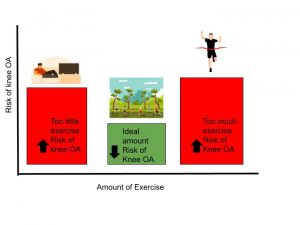I recently attended a webinar with knee Orthopaedic surgeon Nigel Hartnett and physiotherapist Christian Barton, on the topic of “Does Running cause or increase the risk of knee OA (osteoarthritis)?”
They looked at extensive research around the world relating to running and osteoarthritis. They were interested to know if running causes knee OA and if you run with OA will it become worse? The results are quite interesting, and really positive for many of the runners out there.
What does the research show with running and knee OA?
First of all, a history of leisure time running is NOT associated with:
- Increased knee pain
- Increased radiographic OA
- Increased symptomatic OA
In fact:
- 10 out of 100 sedentary people (non-runners) have knee OA
- 3 out of 100 recreational runners have knee OA
- 13 out of 100 elite runners have knee OA (elite meaning running at professional and international levels)

So, while significant amounts of running can increase your risk of knee osteoarthritis, doing nothing can also increase your risk! The happy medium of the recreational runner appears to actually REDUCE your risk of knee OA.
When you consider that recreational running can prevent at least 35 chronic health conditions (e.g. high blood pressure, heart disease, obesity, diabetes just to name a few), the benefits of running far outweigh the risks.
How much running is too much?
Running > 92 kms a week is associated with increased knee osteoarthritis risk, with one year of long distance running (40km/day) shown to caused weight bearing joint surface damage.
On the flip side, non loading (sedentary lifestyle), even for a limited time, is more likely to cause joint degeneration than regular, life long running. This is because articular cartilage in joints relies on weight bearing for nutrients to diffuse from the surrounding synovial fluid. As such low to moderate volume running has shown to have protective effects to articular cartilage in the knee joint.
What if I am a runner who already has knee OA?
You’re in luck! The good news continues, with research showing that running does not appear to accelerate the progression of existing knee OA in runners >50 years of age.
So if you are a runner with osteoarthritis, you should feel safe continuing to run. If you do develop knee symptoms while running, there are things you can do to assist you to continue to run, and return to pain free running.
How to manage mild knee OA and continue running pain free
- Have a Running Assessment – subtle changes to your running technique can reduce the load going through your new joint. Book into see Lucy today for a running treadmill assessment.
- Look at your load – do you need to slow down or reduce duration or frequency of running in order to remain pain free. A physiotherapist can help guide you through this.
- Strength and Conditioning – improving your glute, quad, hamstring and calf strength and endurance helps provide stability and reduce impact on the knee joint. At PMPP we run GLA:D exercise programs designed specifically for strengthening hips and knees impacted by OA. You can also attend any of our Clinical Exercise Classes, or see one of our physios who can help design a home exercise program for you.
- Footwear – ensure you have the correct shoes for your foot type and regularly replace your shoes to ensure adequate shock absorption reduces load on the knee joint. Check out The Running Company in Albert park, they can help you find the right shoe.
- Medication – Panadol osteo can assist in relieving mild symptoms and allow you to continue recreational running. Check in with your GP prior to starting any new medication.
Take home messages
- Running is good for you!
- Running will not cause knee OA
- Being sedentary will cause knee OA
- Running with knee OA is safe
- There are many ways to manage the risk of running with knee pain/OA
~Sal

